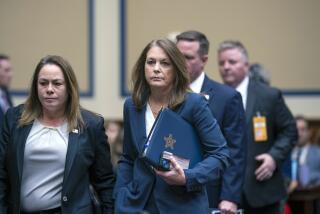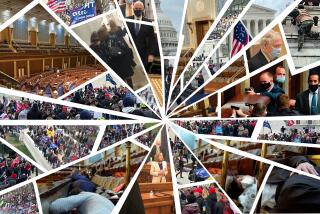Capitol Security Comes Under Renewed Scrutiny
- Share via
WASHINGTON — Congressional leaders were quick to defend security at the U.S. Capitol after Friday’s tragic shootings, yet the incident illustrated mounting dangers that have stirred debate for years.
Since a bomb blew a hole near the entrance to the Senate 15 years ago, the leadership has added external barriers, better metal detectors, new procedures and even bodyguards to protect the members. On Friday evening, leaders declared that the security procedures had worked.
“On an initial assessment, everything went as planned,” said Rep. William M. Thomas (R-Bakersfield), who has jurisdiction over the issue as chairman of the House Oversight Committee. “The worst thing we could do is cower in fear and shut down the people’s Capitol.”
Yet the shooting marked the sixth time that the Capitol has been attacked with bombs or firearms in this century, and many analysts contended the risks continue to increase with the rising threat of domestic and foreign terrorism.
The most powerful wake-up call came in November 1983, when a bomb went off outside the entrance near the Senate Republican cloakroom. No one was injured, but the blast destroyed historic artwork, a precious clock and hand-carved woodwork.
Until that incident, the movement of lawmakers and the public around Capitol Hill was largely unhindered. Visitors had virtually unlimited access to the building, and the metal detecting equipment--which was old and inefficient--was used only intermittently.
Even groups of angry protesters could mill on Capitol Hill with little check on their movements. And no one inside the building was required to wear an identification tag.
The 1983 bombing, for which a mysterious group called the Armed Resistance Unit claimed responsibility, brought about new layers of security. Others have been added over the years.
After committee analysis and reviews by the General Accounting Office, congressional leaders ordered the erection of large concrete barriers and huge planters at vehicular entrances. Some areas have been cut off to parking and driving entirely. And special mirrors have been fastened to the ends of poles that police use to scan the underside of cars for bombs. Parking in the area is sharply limited.
Police now funnel tourists through a small number of entrances that are equipped with modern metal detectors.
Tourists entering must send their bags through these detectors, and they can be searched further by the U.S. Capitol Police, who guard the open entrances. People can still move unescorted through many hallways, but other areas are off limits except when visitors are with an official escort.
Each time such major violence shocks the nation, Congress reviews its security--and usually increases its safeguards. After the bombing of the federal building in Oklahoma City in 1995, for example, Congress cut off additional side streets to traffic in Washington and added new barriers.
The congressional leadership, meanwhile, has been adding security personnel to the 1,400-member U.S. Capitol Police force. Rep. Newt Gingrich (R-Ga.) is the first House speaker to be shadowed by bodyguards, and other leaders have plainclothes officers stationed in their offices.
Earlier this year, a supplemental appropriations bill was passed that included $20 million for improved Capitol perimeter security.
“It was considered to be an emergency,” said Art Jutton, chief of staff to Rep. James T. Walsh (R-N.Y.), chairman of the House Appropriations Committee’s legislative branch subcommittee. “There was a concern that there was a need to beef up security.”
Even so, Congress has sought to maintain some open access, and has encouraged members of the police force to be friendly to the tide of tourists. They are taught the history of the building so they can share information, and they are far more relaxed and friendly than, for example, the uniformed Secret Service agents who guard the White House perimeter.
Some members of Congress joined Thomas on Friday in arguing that this incident should not panic lawmakers into seeking more restrictive security measures, such as the iron perimeter fence that has been proposed often in the past, but always shot down.
“We must not overreact,” said Rep. Eleanor Holmes Norton (D-D.C.). “This is not a breach of security. As far as we can tell, this is some maniac who came blazing in.”
Congress should not repeat the drastic step taken three years ago when it closed Pennsylvania Avenue around the White House in the aftermath of the Oklahoma City bombing, Norton said.
Even so, some congressional aides predicted the tragedy would give rise to new calls from security experts for additional measures. One proposal: To move the metal detectors outside the Capitol entrances.
“I’ll bet you, before not too long, we’re going to have a fence around this place,” said one aide who asked to remain unidentified. He lamented the increasing moves toward a “fortress Washington.”
Times staff writer Janet Hook contributed to this story.
(BEGIN TEXT OF INFOBOX / INFOGRAPHIC)
Past Capitol Violence
Some of the violent incidents that have taken place in the Capitol:
SHOOTINGS
March 1954: 5 congressmen are shot on the floor of the House after three Puerto Rican extremists of the Nationalist Party fire shots from the visitor’s gallery. A fourth assailant is captured later.
July 1947: Sen. John W. Bricker (R-Ohio) is shot twice as he enters the Senate subway. Both shots miss. The gunman is William L. Kaiser, a former Capitol policeman who had lost money when an Ohio building and loan firm was liquidated.
****
BOMBINGS
November 1983: A bomb rips through the second floor of the Capitol, damaging a conference room and the offices of Sen. Robert C. Byrd (D-W.Va.). No one is injured. A caller had phoned the Washington Post warning that a bomb was about to explode. The caller claimed to be from a group calling itself the Armed Resistance Unit and said the action was in response to U.S. military aggression in Grenada and Lebanon.
March 1971: A bomb exploded in a Senate restroom explodes, causing extensive damage but no injuries. It comes at a time of rising opposition to U.S. policies in Vietnam.
July 1915: The Senate Reception Room is damaged by the explosion of a homemade bombed placed there by Erich Muenter, a former Harvard professor who is upset by the private sales of U.S. munitions to the allies in World War I.
Sources: Times wire services
compiled by TRICIA FORD / Los Angeles Times
More to Read
Sign up for Essential California
The most important California stories and recommendations in your inbox every morning.
You may occasionally receive promotional content from the Los Angeles Times.














